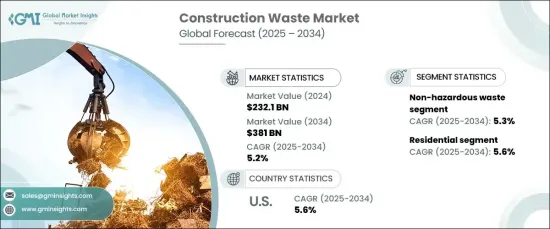PUBLISHER: Global Market Insights Inc. | PRODUCT CODE: 1665407

PUBLISHER: Global Market Insights Inc. | PRODUCT CODE: 1665407
Construction Waste Market Opportunity, Growth Drivers, Industry Trend Analysis, and Forecast 2024 - 2032
The Global Construction Waste Market was valued at USD 232.1 billion in 2023 and is projected to expand at a CAGR of 5.2% from 2025 to 2034. The increasing pace of urbanization and infrastructure expansion is driving a notable surge in construction activities across developed and developing regions. This rapid development has led to a significant rise in construction and demolition waste generation, fueling the demand for efficient waste management solutions.

Governments worldwide are introducing stringent regulations to mitigate the environmental impact of construction waste. These policies emphasize recycling materials, reducing landfill dependency, and promoting sustainable practices. Additionally, the global push toward circular economy principles highlights the importance of reusing and recycling construction materials, which is contributing to market growth. However, the high costs associated with waste sorting, processing, and recycling remain a key challenge for the industry. Many companies face financial barriers to adopting sustainable waste management practices, especially in the absence of strong regulatory incentives.
| Market Scope | |
|---|---|
| Start Year | 2023 |
| Forecast Year | 2024-2032 |
| Start Value | $232.1 Billion |
| Forecast Value | $381 Billion |
| CAGR | 5.2% |
Non-hazardous waste, which accounted for USD 186.4 billion in 2024, is expected to grow at a CAGR of 5.3% through 2034. This segment benefits from the ease of recycling materials like concrete, bricks, and wood, which dominate construction and demolition waste streams. Additionally, increasing adoption of eco-friendly building methods and government mandates for recycling non-hazardous waste are further driving this segment's growth.
The residential construction sector secured a 40.6% revenue share in 2024 and is forecasted to grow at a CAGR of 5.6% through 2034. Residential projects contribute heavily to waste generation, especially during new construction, renovation, or demolition activities. The expansion of affordable housing initiatives and urban infrastructure development worldwide are also playing a significant role in driving waste volumes from this segment.
The US construction waste market alone surpassed USD 44.1 billion in 2024, with expectations of a 5.6% CAGR through 2034. Population growth and increased construction activity have contributed to this rise, with the sector playing a pivotal role in the national economy. As construction establishments continue to grow, demand for waste management solutions will likely remain strong, ensuring steady market growth.
Table of Contents
Chapter 1 Methodology & Scope
- 1.1 Market scope & definition
- 1.2 Base estimates & calculations
- 1.3 Forecast parameters
- 1.4 Data sources
- 1.4.1 Primary
- 1.4.2 Secondary
- 1.4.2.1 Paid sources
- 1.4.2.2 Public sources
Chapter 2 Executive Summary
- 2.1 Industry 3600 synopsis, 2021 - 2034
Chapter 3 Industry Insights
- 3.1 Industry ecosystem analysis
- 3.1.1 Factors affecting the value chain
- 3.1.2 Profit margin analysis
- 3.1.3 Disruptions
- 3.1.4 Future outlook
- 3.1.5 Manufacturers
- 3.1.6 Distributors
- 3.1.7 Retailers
- 3.2 Impact forces
- 3.2.1 Growth drivers
- 3.2.1.1 Increase in urbanization and infrastructure development
- 3.2.1.2 Government regulations and sustainability initiatives
- 3.2.1.3 Increasing construction and demolition activities
- 3.2.2 Industry pitfalls & challenges
- 3.2.2.1 High costs of recycling and waste management
- 3.2.2.2 Lack of efficient recycling infrastructure
- 3.2.1 Growth drivers
- 3.3 Technology & innovation landscape
- 3.4 Consumer buying behavior analysis
- 3.4.1 Demographic trends
- 3.4.2 Factors affecting buying decision
- 3.4.3 Consumer product adoption
- 3.4.4 Preferred distribution channel
- 3.5 Growth potential analysis
- 3.6 Regulatory landscape
- 3.7 Pricing analysis
- 3.8 Porter’s analysis
- 3.9 PESTEL analysis
Chapter 4 Competitive Landscape, 2024
- 4.1 Introduction
- 4.2 Company market share analysis
- 4.3 Competitive positioning matrix
- 4.4 Strategic outlook matrix
Chapter 5 Market Estimates & Forecast, By Waste Type, 2021 – 2034, (USD Billion)
- 5.1 Key trends
- 5.2 Hazardous
- 5.3 Non-hazardous
Chapter 6 Market Estimates & Forecast, By Material, 2021 – 2034, (USD Billion)
- 6.1 Key trends
- 6.2 Soil, sand, & gravel
- 6.3 Concrete
- 6.4 Bricks & masonry
- 6.5 Wood
- 6.6 Metal
- 6.7 Others
Chapter 7 Market Estimates & Forecast, By Source, 2021 – 2034, (USD Billion)
- 7.1 Key trends
- 7.2 Residential
- 7.3 Commercial
- 7.4 Industrial
Chapter 8 Market Estimates & Forecast, By Service, 2021 – 2034, (USD Billion)
- 8.1 Key trends
- 8.2 Collection
- 8.3 Transportation
- 8.4 Disposal
Chapter 9 Market Estimates & Forecast, By Region, 2021 – 2034, (USD Billion)
- 9.1 Key trends
- 9.2 North America
- 9.2.1 U.S.
- 9.2.2 Canada
- 9.3 Europe
- 9.3.1 Germany
- 9.3.2 UK
- 9.3.3 France
- 9.3.4 Italy
- 9.3.5 Spain
- 9.4 Asia Pacific
- 9.4.1 China
- 9.4.2 India
- 9.4.3 Japan
- 9.4.4 South Korea
- 9.4.5 Australia
- 9.4.6 Malaysia
- 9.4.7 Indonesia
- 9.5 Latin America
- 9.5.1 Brazil
- 9.5.2 Mexico
- 9.6 MEA
- 9.6.1 Saudi Arabia
- 9.6.2 UAE
- 9.6.3 South Africa
Chapter 10 Company Profiles (Business Overview, Financial Data, Product Landscape, Strategic Outlook, SWOT Analysis)
- 10.1 Casella Waste Systems, Inc.
- 10.2 Clean Harbors, Inc.
- 10.3 Cleanaway Waster Management Limited
- 10.4 Daiseki Co., Ltd.
- 10.5 FCC Environment Limited
- 10.6 GFL Environmental Inc.
- 10.7 Kiverco
- 10.8 Metso Corporation
- 10.9 Remondis
- 10.10 Renewi plc
- 10.11 Republic Services
- 10.12 Veolia Environment S.A.
- 10.13 Waste Connections
- 10.14 Windsor Waste
- 10.15 WM Intellectual Property Holdings, LLC




